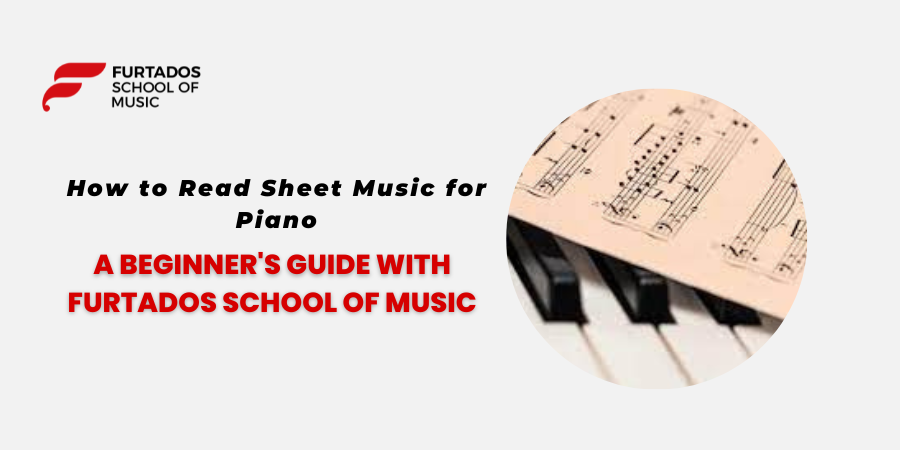Learning to play the piano is an exciting journey, and one of the first steps to becoming a proficient pianist is understanding how to read sheet music. Whether you’re taking piano classes or piano lessons at Furtados School of Music or embarking on your musical adventure independently, this beginner’s guide will help demystify the world of sheet music and empower you to express yourself through the keys.
Why Learn to Read Sheet Music for Piano?
Sheet music is the universal language of music, allowing musicians to communicate and reproduce musical compositions accurately. Here are some compelling reasons why learning to read sheet music is essential for pianists:
- Access to a Vast Repertoire: Sheet music opens the door to a vast and diverse repertoire of music. From classical masterpieces to contemporary hits, you’ll be able to play a wide range of compositions.
- Precision and Accuracy: Sheet music provides precise instructions on how to play each note, including its duration, dynamics, and articulation. This precision is crucial for accurately reproducing a piece of music.
- Communication with Other Musicians: If you ever collaborate with other musicians, knowing how to read sheet music ensures that everyone is on the same page, allowing for seamless ensemble performances.
- Musical Independence: Reading sheet music enables you to learn new songs independently. You can explore and play music that you’ve never heard before.
Now, let’s dive into the basics of reading sheet music for piano.
The Musical Staff and Clefs
Sheet music is organized on a set of horizontal lines and spaces called the musical staff. For piano music, two clefs are commonly used: the treble clef and the bass clef. Each clef is associated with a specific range of notes on the piano:
- Treble Clef: The treble clef, also known as the G clef, is used for higher-pitched notes and is typically played with the right hand. The notes on the treble clef staff include those above middle C.
- Bass Clef: The bass clef, or F clef, is used for lower-pitched notes and is played with the left hand. The notes on the bass clef staff include those below middle C.
The Grand Staff
To represent both hands on the piano, a combination of the treble clef and bass clef is used, creating what is known as the grand staff. The two staves are connected by a vertical line and a brace. Together, they cover the full range of the piano.
Notes on the Staff
Each note on the musical staff corresponds to a specific pitch on the piano. Here are some key points to understand:
- Note Names: Notes are named after the first seven letters of the alphabet: A, B, C, D, E, F, and G.
- Ledger Lines: When a note falls above or below the staff, additional lines, called ledger lines, are used to represent the notes. These lines extend the staff’s range.
- Middle C: Middle C, which is often indicated by a ledger line with a small line through it, serves as a reference point. It is the note located at the center of the grand staff, between the treble and bass clefs.
Note Durations and Time Signatures
Sheet music not only tells you which notes to play but also how long to play them. Note durations are indicated by the shape of the note and the presence of flags or stems. Common note durations include whole notes, half notes, quarter notes, eighth notes, and sixteenth notes.
Time signatures, typically found at the beginning of a piece, indicate the number of beats in each measure and the type of note that receives one beat. For example, in 4/4 time, there are four beats in each measure, and the quarter note receives one beat. Time signatures help you maintain a consistent rhythm while playing.
Key Signatures
Key signatures appear at the beginning of a piece and provide information about which notes are altered (sharp or flat) throughout the composition. Learning key signatures is crucial for understanding the tonality of a piece and knowing which black keys to include in your playing.
Dynamics and Articulation Marks
Sheet music also includes symbols and markings that convey dynamics (volume) and articulation (how to play the notes). Common dynamic markings include:
- piano (p): Play softly.
- forte (f): Play loudly.
- crescendo (cresc.): Gradually increase the volume.
- decrescendo (decresc. or diminuendo): Gradually decrease the volume.
Articulation marks indicate how to perform each note. Examples include:
- legato: Play the notes smoothly and connected.
- staccato: Play the notes short and detached.
- accent: Emphasize the note by playing it with slightly more force.
Practice and Patience
Learning to read sheet music for piano is a skill that requires practice and patience. Start with simple pieces and gradually work your way up to more complex compositions. As you progress in your piano classes or piano lessons at Furtados School of Music, you’ll become more comfortable with interpreting and playing sheet music. Remember that practice is the key to mastery, and reading sheet music will open up a world of musical possibilities for you as a pianist.
